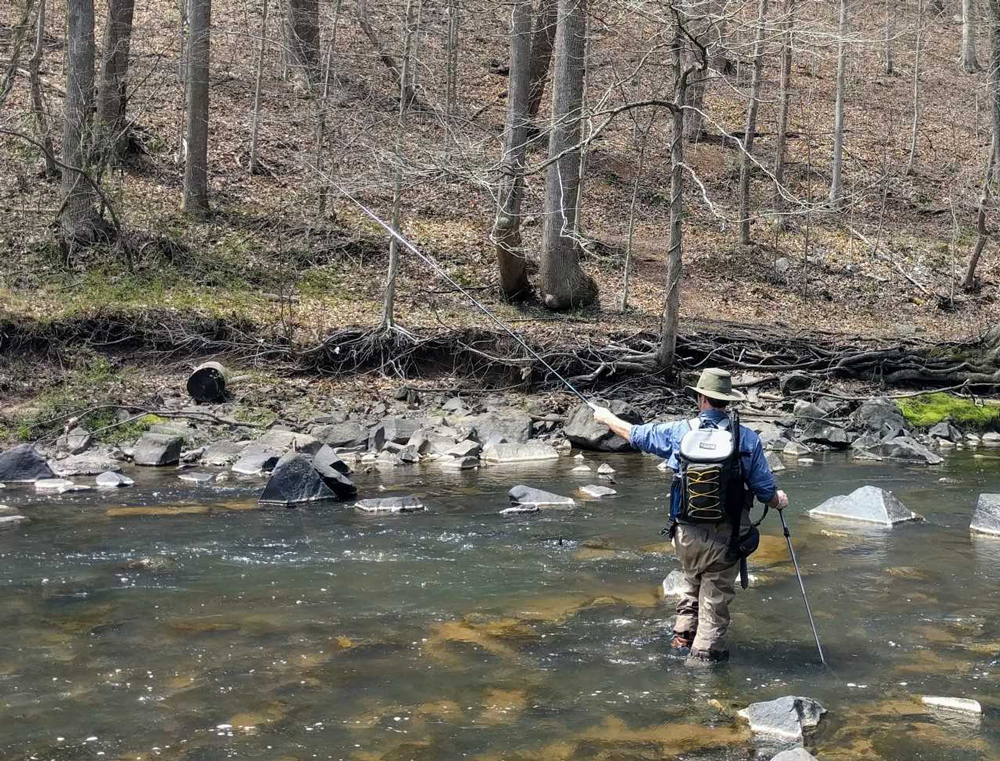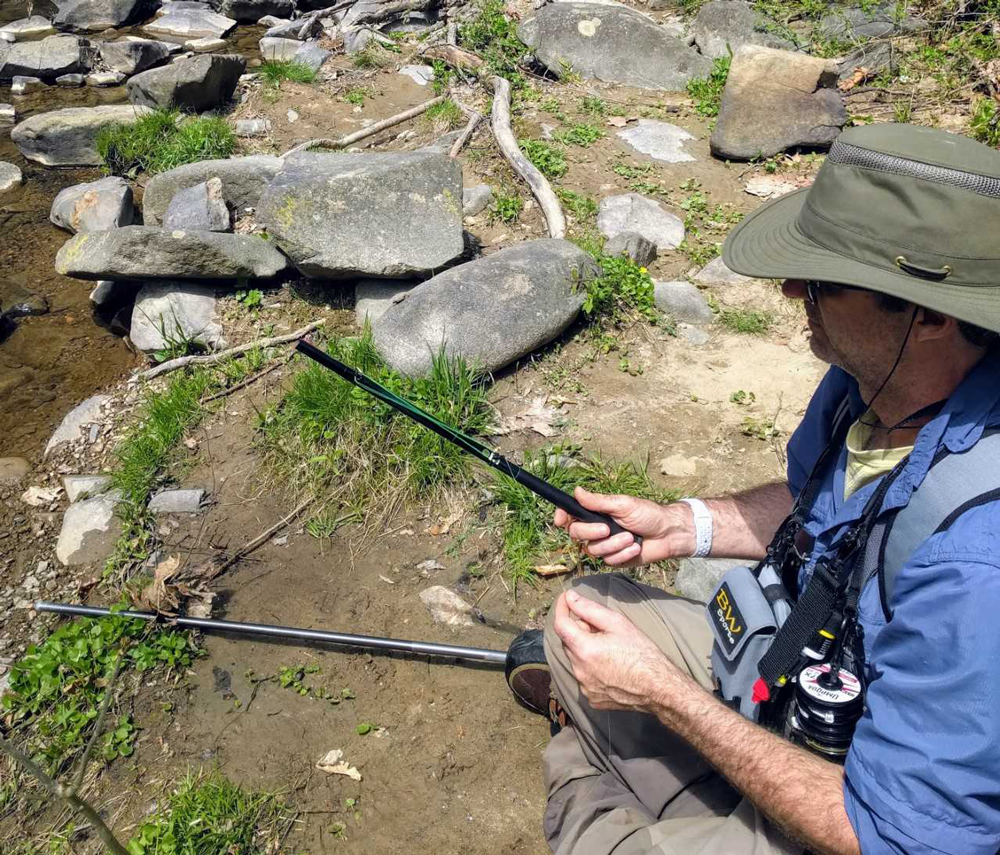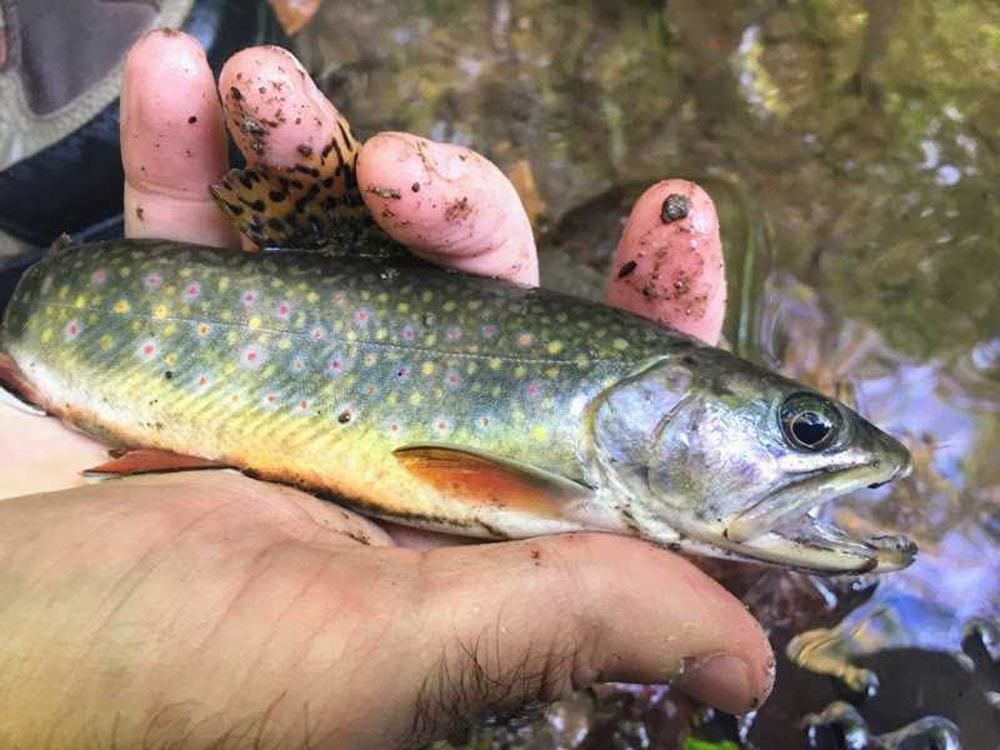Fly fishing takes many different forms, and fly fishing in saltwater is very popular in the Mid-Atlantic region, but a very different type of fly fishing called Tenkara is growing in popularity. Tenkara originated in 17th century Japan, and was used by sustenance fishermen to feed themselves, their families, and as a source of income. Fishing for pleasure was not a consideration, because if they didn’t catch fish — and lots of them — they went to bed hungry. Although Tenkara was designed to be nothing but efficient, today it’s evolved into a different form of the sport we call fly fishing.

The tackle used in Tenkara fishing reflects this need. These 17th century fishermen used a bamboo pole of about 12 feet in length and a horsehair line tied directly to its end. This style of fishing was perfectly suited to Japan’s small and high-gradient streams. Rarely did the fisherman need to cast more than 20 feet, and with a 12 foot rod and 12 or more feet of line, that distance was easily attainable.
Simplicity is the overall philosophy behind Tenkara, which is reflected in both the gear and the flies. Modern Tenkara rods are typically made of carbon fiber, are about 12 feet long, and are telescopic. When collapsed, a 12 foot rod can be as short as 18 inches. The line — usually as long as the rod — is followed by about three feet of tippet which is attached directly to the fly. That’s all there is: a rod, line, and a fly. The flies also tend to be very simple, usually consisting of a hook, a body made of nothing more than a bit of thread, and a single feather.

Drag is something fly fishers are all too familiar with — it’s the fly fisher’s nemesis. As much fly fishing is done in streams, there tend to be eddies, swirls, and other contrary currents between the angler and the fly. The current differentials grab any line laying on the surface of the water and tug at it, causing the fly to move faster or slower than the current it’s in. Trout are instinctive creatures, and when they see a fly moving at a different speed than the current they tend to not recognize it as food and ignore it. Drag may be imperceptible to the fly fisher, but not to the fish that makes its living knowing what is food and what is not. One of the advantages of Tenkara fishing is the almost complete absence of drag. A western-style fly rod uses a heavy PVC coated fly line and the weight of this line causes it to droop and rest on the surface of the water, giving those ever-present currents something to tug on. The western fly fisher has a few strategies to deal with this inherent drag, the most common being the mend. But what if we could simply do away with the conditions that cause drag? There’s not much we can do to get rid of the contrary currents, but with Tenkara, you can avoid them in the first place. The Tenkara line, being much lighter and shorter than western fly line, doesn’t rest on the surface of the water. Instead, it runs almost straight from the tip of the rod to the fly, only touching the surface where it breaks through. With the long length of the rod, you simply reach over the currents.
The Tenkara casting technique is similar to that of western fly fishing, just more delicate. Instead of the normal 10 o’clock to 2 o’clock cast, it uses a smaller 11 o’clock to 1 o’clock motion with a much lighter movement. The overall mechanics are the same. You accelerate as you reach the end of the back-cast, stop for about 1.5 seconds, then accelerate as you reach the terminal point of the forward cast, just as in western-style fly fishing. There’s usually no false casting as there’s no line to feed out from the reel. At the end of the cast the rod tends to stay in the 1 o’clock position and doesn’t get lowered as is done in western fly fishing. It’s a cast that anyone can learn with about 30 minutes of practice.
The flies used in Tenkara fishing tend to be impressionistic, meant to resemble a variety of insects instead of trying to realistically mimic any one thing in particular. They’re usually tied with a simple thread body and one hackle feather tied so the hackles tilt forward over the eye of the hook, as opposed to most western flies where the hackles tilt toward the back of the hook. This causes the hackle feather to open and close as the fly is pulsed in the water, instead of collapsing along the fly’s body.
While many Japanese Tenkara anglers tend to have a ‘one fly’ approach to fishing, that’s not very common in the U.S. With the one fly philosophy, you would simply adjust your presentation as needed for the conditions. While this may sound heretical to most, that technique does have some merit. On high-gradient mountain streams, where Tenkara was born, especially those that are rather unproductive with respect to insect life, it makes perfect sense. Since high-gradient streams move insect life downstream at a fast pace, the fish simply doesn’t have time to give every morsel coming downstream a thorough inspection. An overly picky fish would soon starve, and fish in these waters tend to be more opportunistic. Remember, what a trout eats is usually small, brown, and buggy looking, and if you get close to that you tend to do fine. Of course, during a prolific hatch when the fish are keyed into a certain size and shape, the closer you can get to the real thing the better.
Bringing a fish to the net with a Tenkara rod utilizes a different technique than that of western fly fishing for the simple reason that there’s no reel. The most common technique is to simply angle your wrist back, bringing the rod behind you to pull the fish in closer, then reaching out and netting it. Since there’s no reel there’s also no drag but the rod, being suppler than a western fly rod, tends to act like a shock-absorber. If a fish decides to take a last-second run with a sudden jerk the rod will usually absorb the shock, keeping the tippet intact.

Tenkara rods are arguably the most travel friendly rods available. They’re very portable and quick to set up. They’re telescopic, easily collapsed, and weigh only about three ounces, making them easy to stuff in a backpack. Moving from spot to spot with a Tenkara rod is also quite easy as you don’t have to thread the rod through the underbrush. When the rod is collapsed the line is contained in various styles of line keepers, and stays attached to the rod and fly. Once you get to your next fishing spot you simply let the line out of the keeper, extend the rod, and you’re fishing within 30 seconds. With the portability of a Tenkara rod there’s really no reason not to take one on your next backpacking adventure.
Many anglers have successfully fished with Tenkara gear in warm water ponds, lakes, and even saltwater. If you’ve been wanting to get into fly fishing but were concerned about the complicated casting, give Tenkara a try. Even if you’re already a seasoned fly fisher you, may very well appreciate the simplicity that Tenkara has to offer.
- By Todd Parks